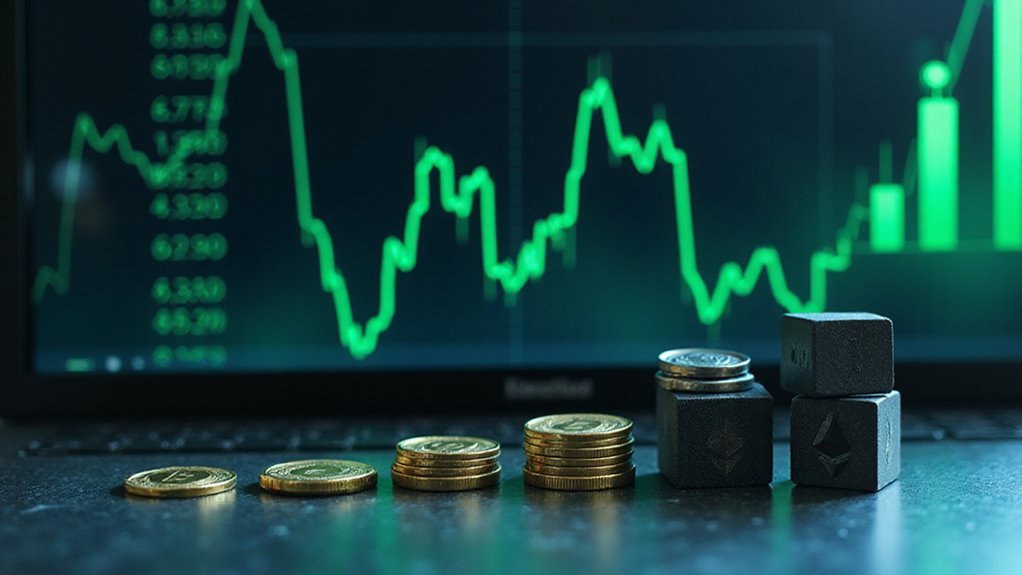Market cap—short for market capitalization—represents a company’s total value in the financial marketplace, calculated by multiplying share price by outstanding shares. This widely-tracked metric fluctuates daily with investor sentiment (often disregarding actual business fundamentals) and serves as the basis for categorizing companies from micro-caps to mega-caps exceeding $200 billion. Unlike enterprise value, market cap ignores debt structures and cash positions, making it an imperfect yet ubiquitous valuation snapshot. Further exploration reveals its surprising limitations and real-world implications.

Market capitalization—or “market cap” as it’s colloquially known in financial circles—represents the total dollar value of a company’s outstanding shares, serving as the primary metric by which investors gauge a firm’s overall size and worth in the public markets.
This deceptively simple calculation—performed by multiplying the current share price by the total number of outstanding shares—fluctuates daily as stock prices dance to the fickle rhythm of market sentiment, often with scant regard for underlying business fundamentals.
Market cap pirouettes with share prices, a daily valuation ballet performed to sentiment’s capricious tune rather than business reality.
Investors routinely classify companies into distinct categories based on their market caps, with lines of demarcation separating the corporate behemoths (mega-caps exceeding $200 billion) from their smaller counterparts.
These classifications—ranging from large-caps ($10+ billion) through mid-caps, small-caps, and down to the speculative micro-cap territory—serve as shorthand for risk profiles and growth expectations.
Large-caps typically offer stability (if not excitement), while small-caps tantalize with growth potential (and corresponding volatility).
Market cap reflects investor perception rather than measuring the intrinsic worth or actual equity value of a company.
The metric’s ubiquity belies its limitations.
Market cap stubbornly ignores debt structures and cash reserves—a company might be worth $50 billion by market cap while simultaneously drowning in liabilities.
This explains why sophisticated analysts often pivot to enterprise value, which accounts for debt and cash positions when evaluating acquisition targets or comparing companies with disparate capital structures.
The global total market capitalization reached an impressive US$126 trillion in 2024, demonstrating the enormous scale of worldwide equity markets.
In cryptocurrency markets, market cap follows the same basic principle using the formula circulating supply multiplied by current price, providing a snapshot of a digital asset’s relative size in the crypto ecosystem.
Recent history offers instructive examples of market cap’s capriciousness.
NVIDIA surged past the $2 trillion threshold during the AI boom, while GameStop’s short squeeze propelled it to a briefly astronomical $40 billion—valuations that would have seemed preposterous just months earlier.
Meanwhile, Saudi Aramco‘s 2019 IPO valuation exceeded $2 trillion, creating momentary confusion about whether oil or technology would dominate the market cap leaderboards.
For all its flaws, market capitalization remains the lingua franca of the investment world—the first figure cited when discussing company size and the foundation upon which countless investment strategies and indexes are constructed.
In finance’s alphabet soup of metrics, it retains primacy of place.
Frequently Asked Questions
How Often Is Market Cap Updated?
Market capitalization updates occur in real-time during trading hours, fluctuating with each stock transaction that alters share price.
This continuous recalculation—a digital reflection of collective market sentiment—creates a perpetually shifting valuation landscape.
While the formula remains static (price × outstanding shares), the inputs dance incessantly to the rhythm of global markets.
Between trading sessions, market cap stands frozen, a financial still-life awaiting the next opening bell to resume its ceaseless transformation.
Can a Company Manipulate Its Market Cap?
While companies cannot directly manipulate market cap (that pesky formula being simply price × shares outstanding), they can influence it through legal means like share buybacks, stock splits, or strategic announcements.
Securities laws and regulatory oversight make sustained artificial inflation nearly impossible—though history offers no shortage of creative attempts.
The real challenge isn’t manipulation but rather the market’s inherent volatility, where investor sentiment can dramatically shift valuations regardless of a company’s machinations.
Do Private Companies Have Market Caps?
Private companies, by definition, don’t possess market capitalizations in the traditional sense.
Unlike their public counterparts—whose worth is calculated by multiplying outstanding shares by current market price—private firms lack publicly traded shares necessary for this valuation mechanism.
Instead, these enterprises rely on alternative methodologies (comparable analysis, enterprise value calculations, or recent industry transactions) to establish their worth.
The Lincoln Private Market Index tracks these valuations quarterly, though such estimates remain inherently less transparent than the real-time valuations public companies endure.
How Does Market Cap Affect Stock Price Volatility?
Market cap inversely correlates with stock volatility—smaller caps exhibit more pronounced price swings due to limited liquidity and narrower investor bases.
These diminutive market participants (often prey to speculative trading) can experience seismic shifts from relatively modest trading volumes.
Conversely, large-cap stocks—those behemoths with their institutional investor following and robust trading volumes—tend toward stability, their prices fluctuating with the gentle predictability of ocean tides rather than the dramatic lurches of their smaller counterparts.
Is Market Cap a Good Indicator of Investment Quality?
Market cap provides insight into investment quality but remains merely one metric in a constellation of factors deserving consideration.
While larger caps generally signal stability and reduced volatility—characteristics appealing to risk-averse investors—they hardly guarantee superior returns.
Savvy investors recognize that market cap must be contextualized alongside profitability metrics, growth prospects, competitive positioning, and broader economic conditions.
The metric’s true utility emerges when properly situated within a thorough analytical framework, rather than when examined in isolation.









